-
RESEARCH01-01-2017
Developing skills learning in obstetric nursing: approaches between theory and practice
Revista Brasileira de Enfermagem. 2017;70(5):1054-1060
Abstract
RESEARCHDeveloping skills learning in obstetric nursing: approaches between theory and practice
Revista Brasileira de Enfermagem. 2017;70(5):1054-1060
DOI 10.1590/0034-7167-2016-0665
Views0See moreABSTRACT
Objective:
To analyze the development of professional skills in an obstetric nursing graduate course.
Method:
Qualitative research, applying semi-structured interviews with 11 students in the obstetric nursing specialization at the State University of Ceará. Data was submitted to thematic review.
Results:
According to the subjects, the course offers the development of skills to strengthen and expand the range of activities in obstetric nursing. Despite relying on previous knowledge and experience acquired by the students, there is a gap between the content taught and internship practice, presented as challenges and difficulties faced by the students. The findings suggest a need for curricular revision, incorporating active teaching-learning methodologies, to overcome the disjunction between theory and practice.
Final considerations:
Students are part of a corpus that is potentially implicated in the construction and transformation of thoughts and values set forth by educational and health institutions, and it is necessary to make changes in political and social organizations, with a focus on providing comprehensive and egalitarian care to the population.
-
RESEARCH01-01-2017
Chronic hepatitis B and D: prognosis according to Child-Pugh score
Revista Brasileira de Enfermagem. 2017;70(5):1048-1053
Abstract
RESEARCHChronic hepatitis B and D: prognosis according to Child-Pugh score
Revista Brasileira de Enfermagem. 2017;70(5):1048-1053
DOI 10.1590/0034-7167-2016-0205
Views1See moreABSTRACT
Objective:
compare chronic hepatitis B patients to those superinfected with hepatitis D virus, according to Child-Pugh score regarding disease severity.
Method:
retrospective descriptive study, performed with 59 patients followed in the ambulatory, of which 22 (37.3%) were chronically infected with hepatitis B virus (Group HBV) and 37 (62.7%) superinfected with Delta virus (Group HBV+HDV); variables of sex, age and items of Child-Pugh score were collected by consulting medical records.
Results:
out of the patients, 57.6% were male, with a mean age of 30.5 years. Score A, which indicates lesser severity, was found in 100% of group HBV and 78.4% of group HBV+HDV. Score B, which indicates greater severity, was found only in group HBV+HDV in 21.6% of the patients.
Conclusion:
by means of the Child-Pugh score, it was observed that patients with superinfection by HDV tended to present a worse prognosis.
-
RESEARCH01-01-2017
Humanization in the Intensive Care: perception of family and healthcare professionals
Revista Brasileira de Enfermagem. 2017;70(5):1040-1047
Abstract
RESEARCHHumanization in the Intensive Care: perception of family and healthcare professionals
Revista Brasileira de Enfermagem. 2017;70(5):1040-1047
DOI 10.1590/0034-7167-2016-0281
Views0See moreABSTRACT
Objective:
Understanding perceptions of family members and healthcare professionals about humanization at the Intensive Care Unit (ICU) to direct it to an educational action.
Method:
Exploratory descriptive and qualitative study conducted in an ICU level 3 of a public hospital in Porto Alegre, RS, Brazil, with fourteen subjects, eight family members and six healthcare professionals. Data collection carried out through semi-structured interviews and focus group. Content Analysis was used.
Results:
Emerged categories were: welcoming; communication; ethical and sensible professionalism; unfavorable aspects; perception on humanization; and religiosity/spirituality.
Final considerations:
Although the subjects have expressed their perceptions about humanization in different ways, both groups pointed out the same needs and priorities to improve humanization in Intensive Care. From the results, we created a reflective manual of humanizing assistance practices for professionals, a board to facilitate communication of these professionals with patients and a guideline book for family members.
-
RESEARCH01-01-2017
Knowledge of adolescents regarding sexually transmitted infections and pregnancy
Revista Brasileira de Enfermagem. 2017;70(5):1033-1039
Abstract
RESEARCHKnowledge of adolescents regarding sexually transmitted infections and pregnancy
Revista Brasileira de Enfermagem. 2017;70(5):1033-1039
DOI 10.1590/0034-7167-2016-0531
Views0See moreABSTRACT
Objective:
To investigate the knowledge of adolescents related to sexually transmitted infections (STIs), AIDS, and pregnancy, and understand the role of school in sex education.
Method:
A qualitative descriptive study, developed through a semi-structured interview and a form for participant characterization, with 22 high school students from a public school aged 16 to 19 years. Data were submitted to content analysis.
Results:
After analysis, four thematic categories were developed: sexuality and sex education; understanding of risk behaviors; knowledge of STI/AIDS; and knowledge of and practices for prevention.
Final considerations:
This study showed the need for preventive educational actions for adolescents, because the lack of information contributes to their vulnerability. The adolescents recognize the importance of sex education; therefore it is important to implement strategies to promote and protect health in the school environment to encourage and strengthen self-care in health.
-
RESEARCH01-01-2017
Care necessities: the view of the patient and nursing team
Revista Brasileira de Enfermagem. 2017;70(5):1026-1032
Abstract
RESEARCHCare necessities: the view of the patient and nursing team
Revista Brasileira de Enfermagem. 2017;70(5):1026-1032
DOI 10.1590/0034-7167-2016-0197
Views0See moreABSTRACT
Objectives:
To compare care necessities as perceived by the patient and nursing team and to investigate the sociodemographic factors associated with these perceptions.
Method:
A comparative study was conducted in units and hospitalized patients of a hospital institution in the state of São Paulo. The participants comprised 100 health professionals (50 nurses and 50 nursing technicians and auxiliaries) and 50 patients. A questionnaire was constructed and validated regarding care needs and was completed by the participants.
Results:
Considering cut-off value kappa ≥ 0.61, or that is, good and very good intervals, the greatest agreement between the perception of the patients and the nursing team was in the areas of: Care and Communication, both with 92.6% agreement; followed by Basic Care with 74.1%. The lowest value was found in the field of Care Planning and Organization, 64.3%.
Conclusion:
In a general manner, there was an agreement between the care needs from the view of the patients themselves and the nursing team.
-
RESEARCH01-01-2017
Critical incidents connected to nurses’ leadership in Intensive Care Units
Revista Brasileira de Enfermagem. 2017;70(5):1018-1025
Abstract
RESEARCHCritical incidents connected to nurses’ leadership in Intensive Care Units
Revista Brasileira de Enfermagem. 2017;70(5):1018-1025
DOI 10.1590/0034-7167-2016-0137
Views0See moreABSTRACT
Objective:
The goal of this study is to analyze nurses’ leadership in intensive care units at hospitals in the state of São Paulo, Brazil, in the face of positive and negative critical incidents.
Method:
Exploratory, descriptive study, conducted with 24 nurses by using the Critical Incident Technique as a methodological benchmark.
Results:
Results were grouped into 61 critical incidents distributed into categories. Researchers came to the conclusion that leadership-related situations interfere with IC nurses’ behaviors. Among these situations they found: difficulty in the communication process; conflicts in the daily exercise of nurses’ activities; people management; and the setting of high quality care targets.
Final considerations:
Researchers identified a mixed leadership model, leading them to the conclusion that nurses’ knowledge and practice of contemporary leadership theories/styles are crucial because they facilitate the communication process, focusing on behavioral aspects and beliefs, in addition to valuing flexibility. This positively impacts the organization’s results.
-
RESEARCH01-01-2017
Cross-cultural adaptation and validation of the Moral Distress Scale-Revised for nurses
Revista Brasileira de Enfermagem. 2017;70(5):1011-1017
Abstract
RESEARCHCross-cultural adaptation and validation of the Moral Distress Scale-Revised for nurses
Revista Brasileira de Enfermagem. 2017;70(5):1011-1017
DOI 10.1590/0034-7167-2016-0518
Views0See moreABSTRACT
Objective:
Cross-culturally adapt and validate the Moral Distress Scale-Revised for nurses.
Method:
Quantitative, analytical cross-sectional study conducted with 157 nurses of two hospital institutions of Southern Brazil, one public and one philanthropic. Procedures conducted: cultural adaptation of the instrument according to international recommendations; validation for the Brazilian context.
Results:
Face and content validation was considered satisfactory as assessed by a specialist committee and a pretest. The instrument demonstrated satisfactory internal consistency through frequency and intensity analysis per question in the 157 items and per subgroups of the various hospital units. Cronbach’s alpha was 0.88 for the instrument and between 0.76 and 0.94 for hospital units. Pearson’s correlation found a moderate association for moral distress among nurses.
Conclusion:
The Moral Distress Scale-Revised – Brazilian version is a valid instrument for the assessment of moral distress in nurses.
-
RESEARCH01-01-2017
Sexual orientation and quality of life of people living with HIV/Aids
Revista Brasileira de Enfermagem. 2017;70(5):1004-1010
Abstract
RESEARCHSexual orientation and quality of life of people living with HIV/Aids
Revista Brasileira de Enfermagem. 2017;70(5):1004-1010
DOI 10.1590/0034-7167-2016-0420
Views0See moreABSTRACT
Objective:
To analyze whether sexual orientation affects the quality of life of people living with HIV/Aids (PLWHA).
Method:
A cross-sectional analytical study was carried out with 146 PLWHA in Teresina, capital city of the state of Piauí, in 2013, by means of the WHOQOL-HIV-bref. Descriptive analysis and multiple linear regression were used for data analysis.
Results:
There was a prevalence of men (63.7%), non-heterosexual (57.0%), aged between 19 and 39 years (89%). Of the total, 75.5% mentioned presence of negative feelings, such as fear and anxiety, and 38% reported have suffered stigma. With regard to the dimensions investigated, the most affected were “environment” and “level of independence”. Non-heterosexual orientation was negatively associated with quality of life in almost all dimensions.
Conclusion:
Living with HIV/Aids and having a non-heterosexual orientation have a negative impact on quality of life.
-
ORIGINAL ARTICLE12-08-2023
Simulation-based training in Leprosy: development and validation of a scenario for community health workers
Revista Brasileira de Enfermagem. 2023;76:e20230114
Abstract
ORIGINAL ARTICLESimulation-based training in Leprosy: development and validation of a scenario for community health workers
Revista Brasileira de Enfermagem. 2023;76:e20230114
DOI 10.1590/0034-7167-2023-0114
Views0See moreABSTRACT
Objectives:
To build and validate a clinical simulation scenario designed to instruct community health workers (CHWs) in active leprosy case detection.
Methods:
Methodological study involving the development of a simulated clinical scenario and content validation by experts. The Content Validity Index (CVI) was used to determine the level of agreement among the judging commitee, and a descriptive analysis of their recommendations was performed.
Results:
A simulated scenario with a simulated participant was developed — a simulation characterized by low complexity, moderate physical/environmental fidelity, moderate to high psychological fidelity, and high conceptual fidelity, lasting 50 minutes and capable of training up to 10 CHWs simultaneously. The scenario was validated by 14 experts, with a CVI exceeding 80% for all components.
Conclusions:
The validated clinical simulation possesses attributes that make it highly reproducible in various national health contexts, thereby contributing to the global “Towards Zero Leprosy” strategy.
-
ORIGINAL ARTICLE12-08-2023
Knowledge and practices about health among Quilombola men: contributions to health care
Revista Brasileira de Enfermagem. 2023;76:e20230138
Abstract
ORIGINAL ARTICLEKnowledge and practices about health among Quilombola men: contributions to health care
Revista Brasileira de Enfermagem. 2023;76:e20230138
DOI 10.1590/0034-7167-2023-0138
Views1See moreABSTRACT
Objective:
to analyze health knowledge and practices among Quilombola men.
Methods:
a qualitative, descriptive study, carried out with 40 men from two Quilombola communities in Santa Izabel do Pará, state of Pará, Brazil. Individual interviews were carried out using a semi-structured script. Text corpus was subjected to analysis with Interface de R pour les Analyses Multidimensionnelles de Textes et de Questionnaires 0.6, alpha 3, through Descending Hierarchical Classification.
Results:
among participants, eight (20.00%) were aged 55 to 59 years. 382 text segments were identified, with 299 (78.27%) being used, generating five lexical classes, which made up two subcorpora. The classes were organized into four thematic axes, covering knowledge about health and practices to prevent and solve health problems.
Final considerations:
men highlighted popular/traditional wisdom permeated by biomedical knowledge, translating their understanding of how to act to remain or become healthy.
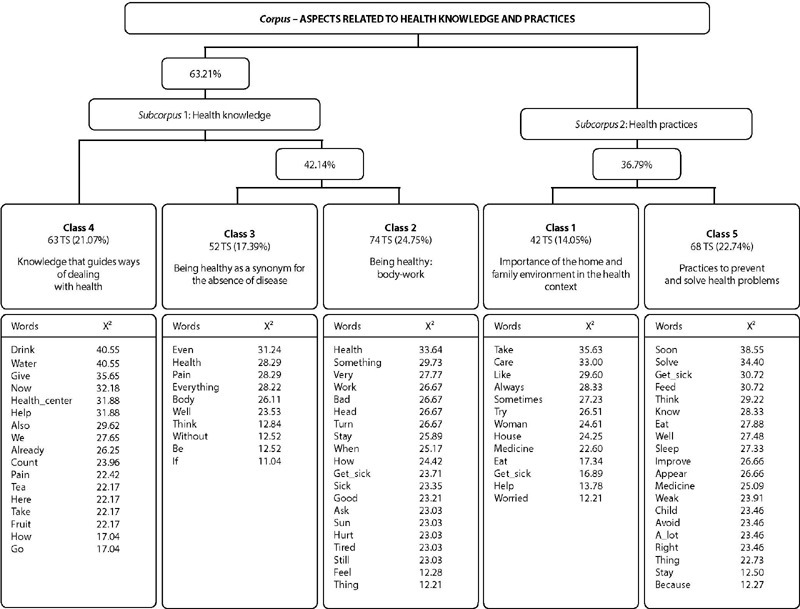
-
ORIGINAL ARTICLE10-06-2023
Ethical problems in nursing teleconsultations for people living with HIV during the Covid-19 pandemic
Revista Brasileira de Enfermagem. 2023;76:e20220754
Abstract
ORIGINAL ARTICLEEthical problems in nursing teleconsultations for people living with HIV during the Covid-19 pandemic
Revista Brasileira de Enfermagem. 2023;76:e20220754
DOI 10.1590/0034-7167-2022-0754
Views0See moreABSTRACT
Objectives:
to understand the ethical problems experienced by primary health care nurses in using nursing teleconsultations for people living with the human immunodeficiency virus during the coronavirus pandemic.
Methods:
qualitative research, anchored in Constructivist Grounded Theory. Data was collected between July and September 2020, with 17 participants.
Results:
the first category highlights the ethical problems in conducting teleconsultations, managing high demand, communication barriers, and risks related to data security. The second emphasizes the potential of teleconsultations in communication and access, by generating changes in the work process and the use of protocols to guide clinical practice.
Conclusions:
nurses’ work in digital mode requires professional qualification, with a view to stimulating reflection on teleconsultation practice, ethical-moral deliberation and combating stigma, and also adopting data security-centered conduct.
-
12-04-2023
Ethical dilemmas at the end of life: a reflection from the Philosophical Perspective of Luigina Mortari
Revista Brasileira de Enfermagem. 2023;76:e20220759
Abstract
Ethical dilemmas at the end of life: a reflection from the Philosophical Perspective of Luigina Mortari
Revista Brasileira de Enfermagem. 2023;76:e20220759
DOI 10.1590/0034-7167-2022-0759
Views0See moreABSTRACT
Objectives:
to reflect on the ethical dilemmas involved in the care of patients at the end of their lives.
Methods:
this is a theoretical-reflective study based on the ethics of care proposed by Luigina Mortari.
Results:
discussing care involves addressing the ways of being inherent to human existence and understanding the unique characteristics of this condition. Ethical care constitutes an action driven by interest in the other and by the perception of their need. Ethical dilemmas are a part of end-of-life care, making it essential to maintain respectful assistance that considers the patient’s autonomy, using strategies for expressing their wishes, and ensuring continuous clear and empathetic communication among all those involved in providing care.
Final Considerations:
issues related to being, stemming from one’s reality of dependency and vulnerability, contribute to the emergence of ethical dilemmas present in care actions.
-
ORIGINAL ARTICLE12-04-2023
Overview of nursing ethics teaching in Brazilian public higher education institutions
Revista Brasileira de Enfermagem. 2023;76:e20220808
Abstract
ORIGINAL ARTICLEOverview of nursing ethics teaching in Brazilian public higher education institutions
Revista Brasileira de Enfermagem. 2023;76:e20220808
DOI 10.1590/0034-7167-2022-0808
Views0See moreABSTRACT
Objectives:
to outline the teaching of ethics in undergraduate Nursing programs in Brazilian public higher education institutions.
Methods:
descriptive and exploratory study, carried out through the documentary analysis of pedagogical projects of undergraduate Nursing programs in Brazil.
Results:
153 active undergraduate Nursing programs were found, of which 106 provide the pedagogical project. In addition to deontological teaching, the teaching of ethics was identified in a transversal way associated with themes such as Social Context, Hospital and Community Care, Pharmacology, Systematization of Nursing Care, Surgical Nursing, Epidemiology, Palliative Care, Management in Nursing, Diversity, Women’s, Children’s, Adolescent’s, Adult’s and Older People’s Health, and Mental Health.
Final Considerations:
the challenge in teaching nursing ethics is its integration with each action of caring, teaching and managing.
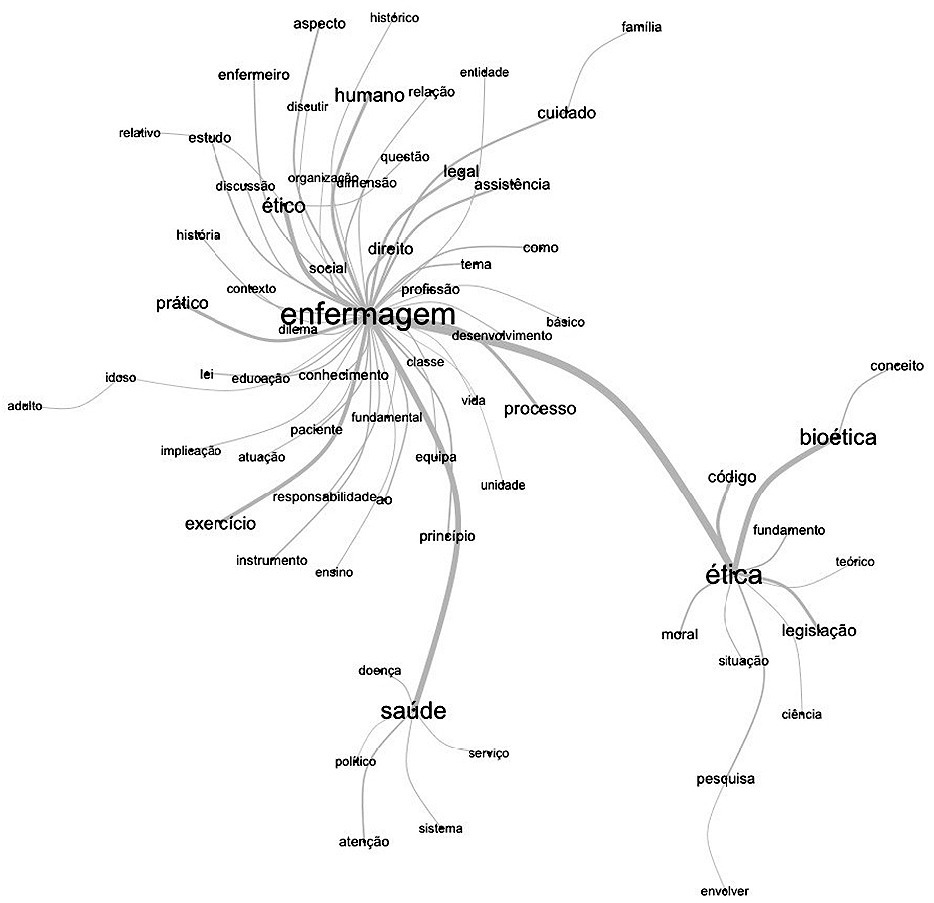
-
ORIGINAL ARTICLE12-08-2023
Validation of telesimulation in the care of late preterm newborns with hypoglycemia for nursing students
Revista Brasileira de Enfermagem. 2023;76:20220438
Abstract
ORIGINAL ARTICLEValidation of telesimulation in the care of late preterm newborns with hypoglycemia for nursing students
Revista Brasileira de Enfermagem. 2023;76:20220438
DOI 10.1590/0034-7167-2022-0438
Views0See moreABSTRACT
Objective:
To develop and validate a telesimulation scenario for nursing students in the care of late preterm infants with hypoglycemia.
Methods:
A methodological study conducted between August 2021 and May 2022 in a virtual environment involved constructing and validating the scenario with 10 experts, and testing it with 10 students. The content validity index assessed validity, with a threshold of 80% or higher, and suggestions were analyzed using semantic approximation.
Results:
Validation confirmed the appropriateness of all 14 scenario items, with an overall index of 97.8% and clarity and relevance indices of 98.5%. During testing, the overall index was 99.7%, with the “resources” item receiving the lowest score. Adjustments were made to objectives, technical terms, resources, and target audience based on feedback.
Conclusion:
Telesimulation is a widely accepted educational technology for training nursing students, with potential to enhance teaching quality and neonatal care.
-
ORIGINAL ARTICLE11-10-2023
Construction and validity of educational technology in audiovisual media on premature newborn care
Revista Brasileira de Enfermagem. 2023;76:e20220403
Abstract
ORIGINAL ARTICLEConstruction and validity of educational technology in audiovisual media on premature newborn care
Revista Brasileira de Enfermagem. 2023;76:e20220403
DOI 10.1590/0034-7167-2022-0403
Views0See moreABSTRACT
Objectives:
to construct and validate an educational video storyboard about care for premature newborns at home.
Methods:
a methodological study, with the construction of an educational video storyboard, validated with 14 judges. Content was selected from scoping review. For data collection, a validated instrument was used. The criterion for validity was agreement greater than 80%, analyzed using the Content Validity Index.
Results:
the storyboard construction was guided by the Cognitive Theory of Multimedia Learning theoretical framework. Construction and validity took place from May to December 2020. The storyboard’s final version lasted 10 minutes, and was validated in terms of objective, structure, presentation and relevance, with a Content Validity Index of 0.9.
Conclusions:
the storyboard of the educational video proved to be valid and adequate for health promotion in developing care for premature newborns at home.

-
ORIGINAL ARTICLE12-08-2023
Early ambulation and dhikr complementary therapies effect on intestinal peristaltic in post-open cholecystectomy patients
Revista Brasileira de Enfermagem. 2023;76:e20220636
Abstract
ORIGINAL ARTICLEEarly ambulation and dhikr complementary therapies effect on intestinal peristaltic in post-open cholecystectomy patients
Revista Brasileira de Enfermagem. 2023;76:e20220636
DOI 10.1590/0034-7167-2022-0636
Views0ABSTRACT
Objectives:
to analyze and determine the effect of a combination intervention of early ambulation and dhikr therapy on intestinal peristaltic recovery in post-open cholecystectomy patients.
Methods:
a pre-experimental design with one group pre and post-test design was used. The samples were 15 post-open cholecystectomy patients which were selected using the purposive sampling technique. The data were collected using the instrument observation sheet and analyzed using the Wilcoxon test. Early ambulation used standard operational procedure in the hospital and dhikr therapy was carried out at 2 hours post-operation for 10-15 minutes.
Results:
there was an effect of early ambulation and dhikr therapy on intestinal peristaltic recovery in post-open cholecystectomy patients with general anesthesia (Z=-3.442; p=0.001).
Conclusions:
a combination of early ambulation and dhikr therapy can be recommended as interventions to improve intestinal peristaltic in a post-open cholecystectomy patient with general anesthesia.
Keywords:Anesthesia, GeneralCholecystectomyComplementary TherapiesEarly AmbulationPerioperative NursingSee more
-
REVIEW10-28-2020
Health care of sexual and gender minorities: an integrative literature review
Revista Brasileira de Enfermagem. 2020;73:e20190192
Abstract
REVIEWHealth care of sexual and gender minorities: an integrative literature review
Revista Brasileira de Enfermagem. 2020;73:e20190192
DOI 10.1590/0034-7167-2019-0192
Views0See moreABSTRACT
Objectives:
to describe health care practices aimed at lesbians, gays, bisexuals, transvestites, and transsexuals.
Methods:
an integrative literature review based on systematic steps, in MEDLINE, LILACS AND SciELO databases and/or electronic libraries. It was held from September to November 2018, with articles published between 2012 and 2017, available in full in Portuguese, English, and Spanish, addressing health care to that population group.
Results:
fourteen articles were included. Most of the articles were about the trajectory of individuals within health services and showed limitations and obstacles in the use of these services.
Final Considerations:
there is evidence that factors related to organization of services, attitude of professionals, stigma, and discrimination experienced undermine health care practices. Therefore, it is essential to carry out educational activities in health services and educational institutions.
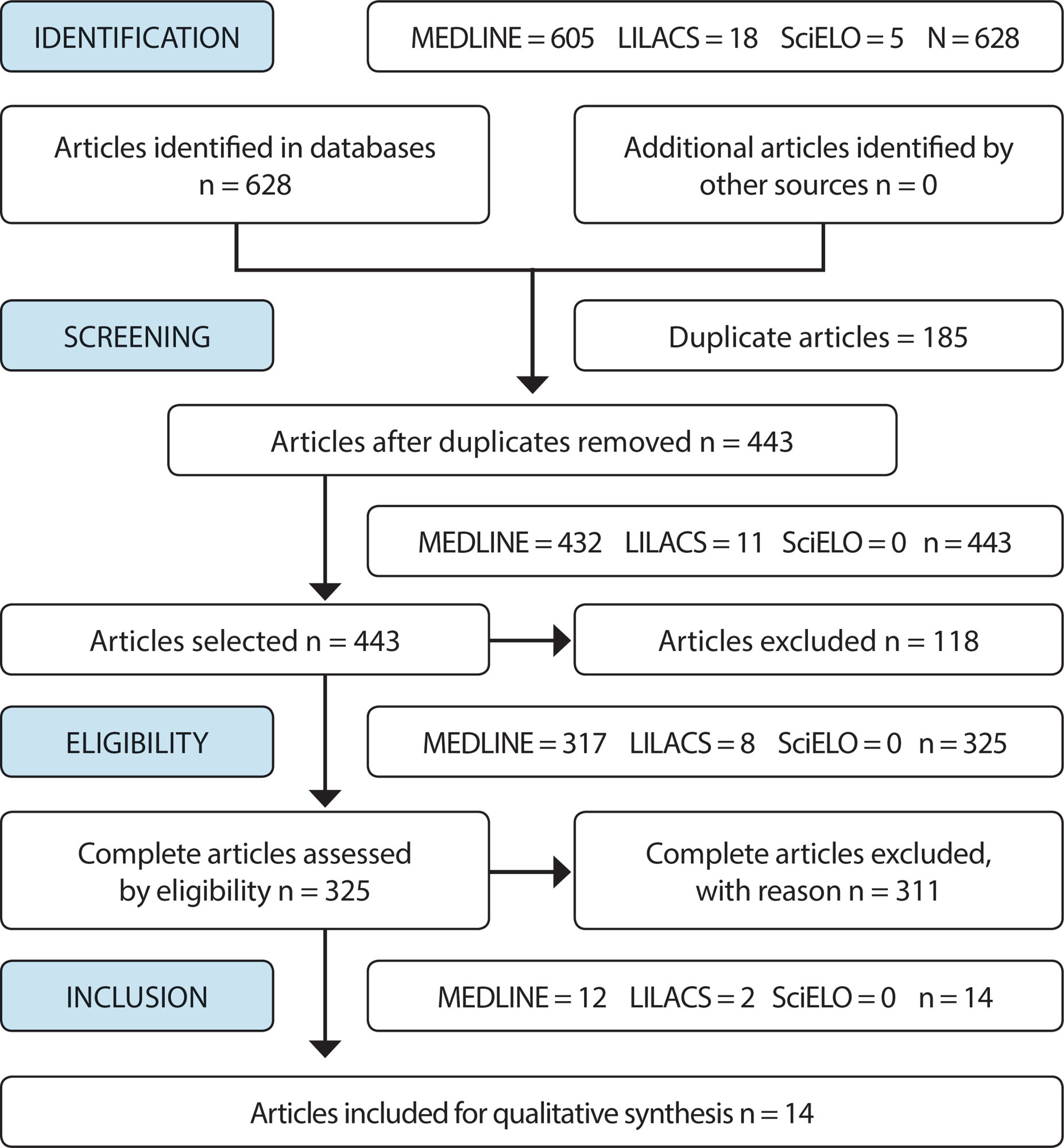
-
ORIGINAL ARTICLE07-06-2020
Nurses’ work process in an emergency hospital service
Revista Brasileira de Enfermagem. 2020;73(5):e20180923
Abstract
ORIGINAL ARTICLENurses’ work process in an emergency hospital service
Revista Brasileira de Enfermagem. 2020;73(5):e20180923
DOI 10.1590/0034-7167-2018-0923
Views1See moreABSTRACT
Objectives:
to analyze the nurses’ work process in an Emergency Hospital Service.
Methods:
a qualitative, exploratory and descriptive research conducted with 17 nurses from the emergency service of a high complexity hospital in southern Brazil. Data were collected through interviews, focus group and document analysis. Data analysis followed the thematic content analysis framework.
Results:
four categories emerged: Work environment characteristics; Assistance dimension; Management dimension; Care management.
Final Considerations:
the nurses’ work process in Emergency Hospital Service is characterized by the peculiarities of the setting, with centrality in care and care management aiming at quality care and safety to patients.
-
EXPERIENCE REPORT09-29-2022
Mobile pre-hospital care reorganization during the COVID-19 pandemic: experience report
Revista Brasileira de Enfermagem. 2022;75:e20200826
Abstract
EXPERIENCE REPORTMobile pre-hospital care reorganization during the COVID-19 pandemic: experience report
Revista Brasileira de Enfermagem. 2022;75:e20200826
DOI 10.1590/0034-7167-2020-0826
Views0See moreABSTRACT
Objective:
To describe the reorganization of Belo Horizonte’s Mobile Emergency Care Service during the new coronavirus pandemic using the Plan Do-Check-Act quality tool.
Methods:
Descriptive study, of the experience report type, on the reorganization of care in a mobile pre-hospital care service during the new coronavirus pandemic, from March to July 2020. The Plan-Do-Check-Act quality tool was applied for the process.
Results:
Preparation of care protocol, meetings, training, addition of ambulances, hiring of professionals, and other actions were carried out, with subsequent evaluation and monitoring. When failures or new needs were identified, actions and changes were implemented while keeping monitoring and evaluation during the work routine.
Final considerations:
The reorganization of the service through the construction of a protocol and using the Plan-Do-Check-Act as a management tool was essential to promote safe care for professionals and patients.

-
ORIGINAL ARTICLE09-21-2020
Adolescents in situations of poverty: resilience and vulnerabilities to sexually transmitted infections
Revista Brasileira de Enfermagem. 2020;73:e20190242
Abstract
ORIGINAL ARTICLEAdolescents in situations of poverty: resilience and vulnerabilities to sexually transmitted infections
Revista Brasileira de Enfermagem. 2020;73:e20190242
DOI 10.1590/0034-7167-2019-0242
Views0See moreABSTRACT
Objective:
To analyze the association between vulnerabilities to Sexually Transmitted Infections (STIs/HIV/AIDS) of adolescents in poverty and their level of resilience.
Method:
Cross-sectional study with 287 students between 11 and 17 years old in a school in the outskirts of Fortaleza-Ce. The study was conducted from August to October 2016. Three instruments related to characterization, vulnerability to STIs/HIV/AIDS and resilience were used. The association between the instruments was calculated using the Mann-Whitney and Kruskal-Wallis tests. Association between vulnerability to STIs/HIV/AIDS and resilience was assessed through the Spearman’s correlation coefficient. Statistical significance was set at p<0.05.
Results:
There was a significant association between the factors “housing” (p=0.022), “family income” (p=0.037) and vulnerability to STIs/HIV/AIDS. Adolescents whose father has completed high school (p=0.043) have moderately high resilience.
Conclusion:
Adolescents with low socioeconomic status and who live on less than a minimum wage tends to be more susceptible to vulnerabilities to STIs/HIV/AIDS and to have low resilience.
-
ORIGINAL ARTICLE06-14-2021
Mothers’ knowledge of premature newborn care and application of Kangaroo Mother Care at home
Revista Brasileira de Enfermagem. 2021;74(6):e20200717
Abstract
ORIGINAL ARTICLEMothers’ knowledge of premature newborn care and application of Kangaroo Mother Care at home
Revista Brasileira de Enfermagem. 2021;74(6):e20200717
DOI 10.1590/0034-7167-2020-0717
Views0See moreABSTRACT
Objective:
to identify mothers’ knowledge about premature newborn care and application of Kangaroo Mother Care at home.
Methods:
a descriptive, qualitative study carried out with 15 mothers of premature newborns in a reference Maternal and Child Hospital in northern Brazil using two semi-structured interviews with open- and closed-ended questions. The testimonies were analyzed using thematic analysis technique, proposed by Bardin.
Results:
two thematic categories originated: “Caring for a premature newborn at home: strengths and weaknesses” and “Applying Kangaroo Mother Care at home: new knowledge acquired during hospitalization”.
Final considerations:
the speeches of the interviewed mothers pointed out their knowledge about home care of premature NBs and understanding the importance of Kangaroo Mother Care, mainly acquired and improved with the guidance of professionals during hospitalization and application of the method, in addition to fears, possible difficulties in home care and the need to be better informed at hospital discharge.
-
ORIGINAL ARTICLE10-01-2022
Musculoskeletal symptoms in formal and informal caregivers of elderly people
Revista Brasileira de Enfermagem. 2022;75(2):e20210249
Abstract
ORIGINAL ARTICLEMusculoskeletal symptoms in formal and informal caregivers of elderly people
Revista Brasileira de Enfermagem. 2022;75(2):e20210249
DOI 10.1590/0034-7167-2021-0249
Views0See moreABSTRACT
Objective:
to evaluate musculoskeletal symptoms in formal and informal caregivers of elderly people, and check association with personal and work-related factors.
Methods:
this is a cross-sectional study. Instruments for assessment were the International Physical Activity Questionnaire, Self-Reporting Questionnaire-20, Borg’s effort perception scale and Nordic Musculoskeletal Questionnaire.
Results:
informal caregivers had been working for a longer time (60.2% vs. 41%), had more hours of work (37.4% >12h for day), less time off (85.4% vs. 2.5%) and lack of care guidelines (90.2%). The region with the most musculoskeletal symptoms was the spine and the greater dependence of the elderly, the greater the chances of developing musculoskeletal symptoms (OR= 1.3, 95% CI= 1.1-1.6, p <0.05).
Conclusion:
personal and work-related factors were more prevalent in informal group and the elderly person’s dependence interferes with the increase in musculoskeletal symptoms of caregivers.
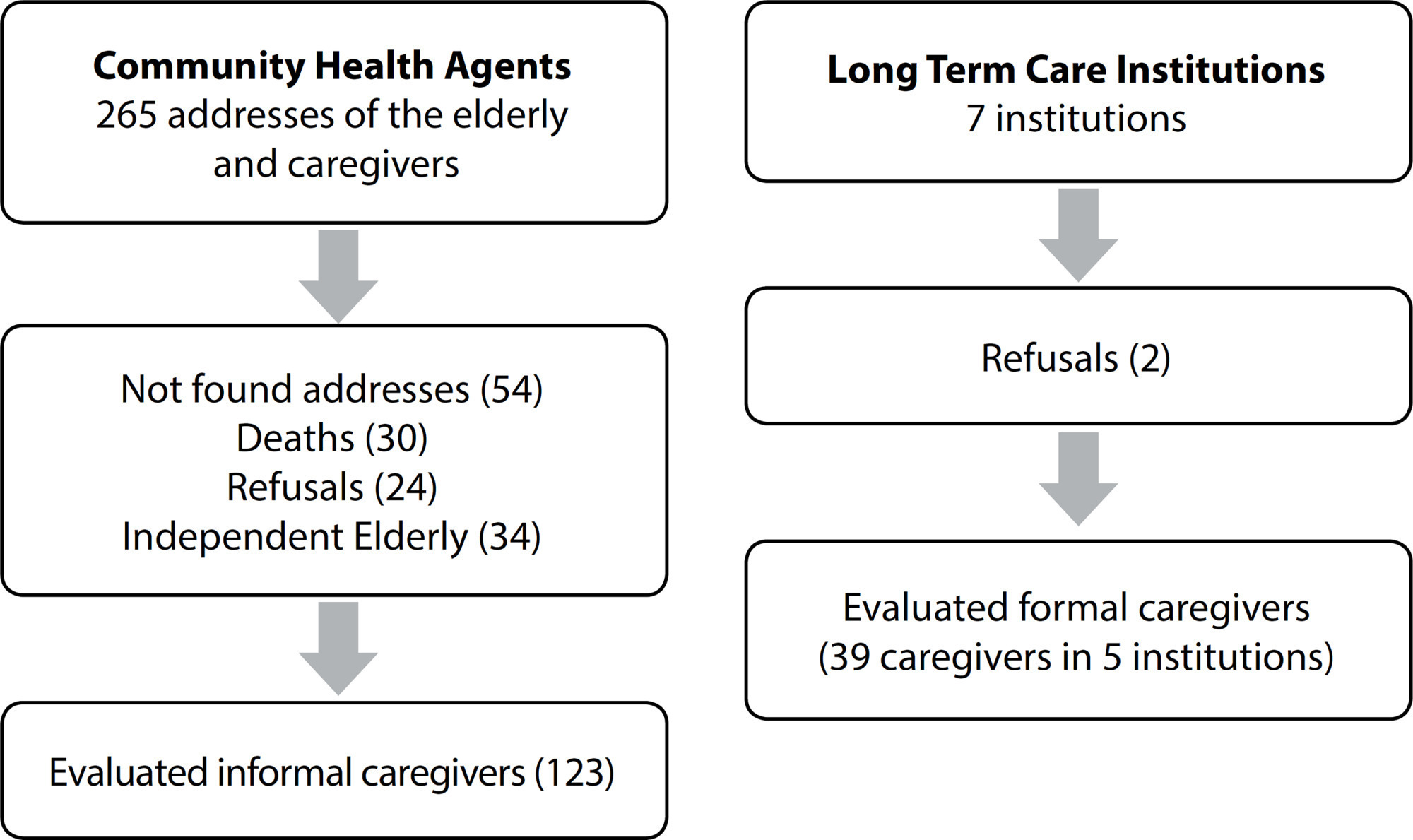
-
REVIEW11-25-2020
Nurse’s interventions in preventing falls in hospitalized children: scoping review
Revista Brasileira de Enfermagem. 2020;73:e20190409
Abstract
REVIEWNurse’s interventions in preventing falls in hospitalized children: scoping review
Revista Brasileira de Enfermagem. 2020;73:e20190409
DOI 10.1590/0034-7167-2019-0409
Views1See moreABSTRACT
Objectives:
map both nursing interventions for the prevention of falls in paediatric age during hospitalization and the instruments for assessing the risk of falls in paediatrics.
Methods:
scoping review according to the protocol of Joanna Briggs Institute, with acronym PCC (P – children, C – fall preventive nursing interventions and instruments for assessing the risk of falling, C – hospital admission), in three sources of information (EBSCO, PubMed and SciELO).
Results:
the sample consisted of seven articles. The education of the child/family is the basis of the interventions, and the instruments for assessing the risk of falling identified were: Humpty Dumpty Falls Scale, GRAF PIF, CUMMINGS, I’M SAFE and CHAMPS.
Conclusions:
the education of children/parents on preventive measures is important and should be reinforced during hospitalization, using different methodologies. The Humpty Dumpty Falls Scale was the most analyzed.
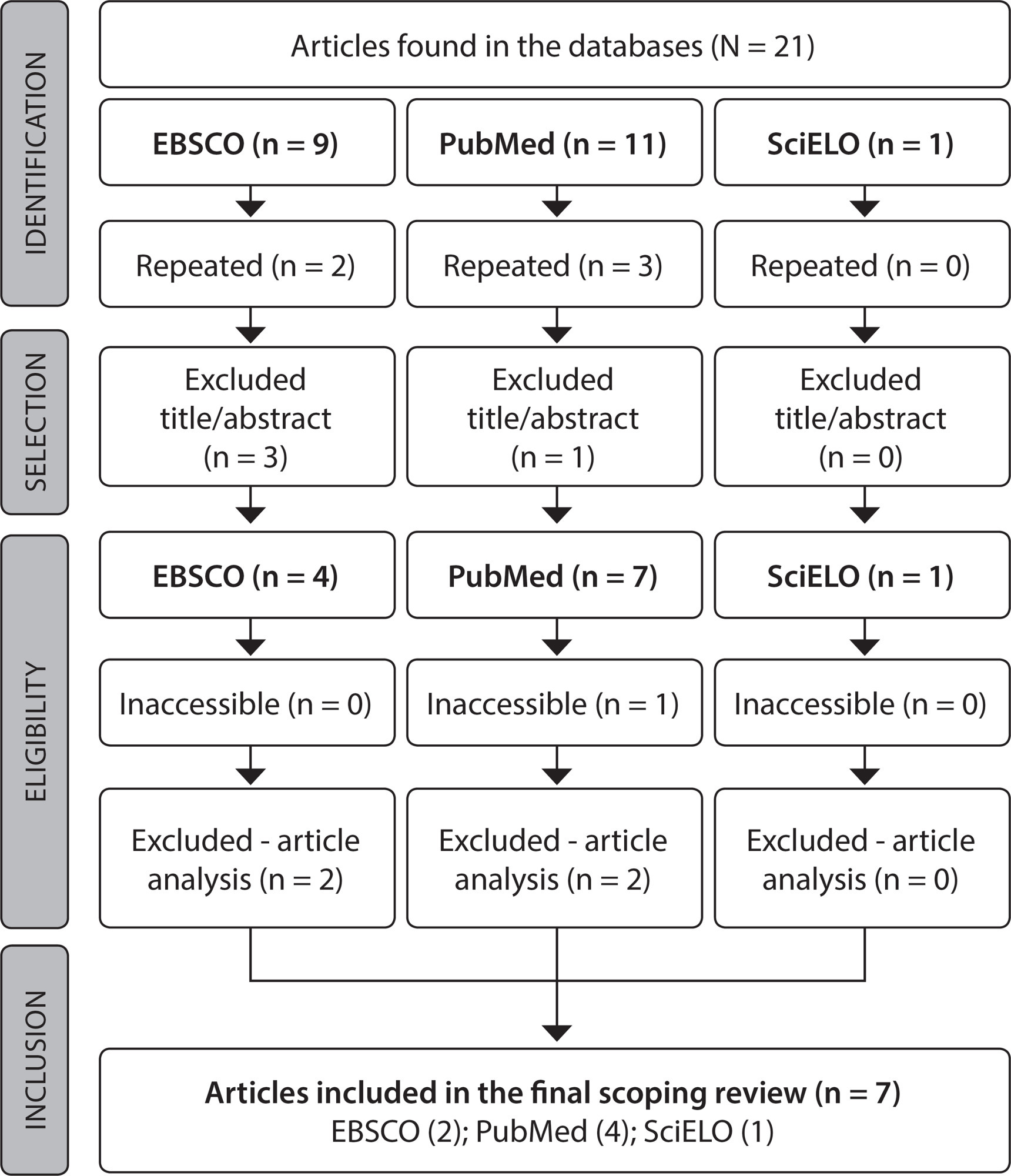
-
ORIGINAL ARTICLE07-10-2020
Formation of protagonist adolescents to prevent bullying in school contexts
Revista Brasileira de Enfermagem. 2020;73:e20190418
Abstract
ORIGINAL ARTICLEFormation of protagonist adolescents to prevent bullying in school contexts
Revista Brasileira de Enfermagem. 2020;73:e20190418
DOI 10.1590/0034-7167-2019-0418
Views0See moreABSTRACT
Objective:
to develop a participative strategy of health education in the formative process of protagonist adolescents aimed at preventing school bullying.
Method:
qualitative interventive-participatory research, based on the Community-Based Participatory Research and in the Culture Circles of Paulo Freire. The sample was intentional, with the participation of 12 adolescents who were considered leaders. For data production at the moment of educational intervention, observation techniques were employed with note-taking in a field diary, plus photographic and video records.
Results:
the pedagogical intervention model raised the opportunity for the adolescents’ active participation, aiming at the development of skills that create pro-social behaviors, empathetic and assertive relations, which are able to face bullying and transform the school environment.
Final considerations:
the use of participative methodologies, in the youth protagonism perspective, has the potential to support educational practices of school nurses in collaboration and leadership of antibullying programs.
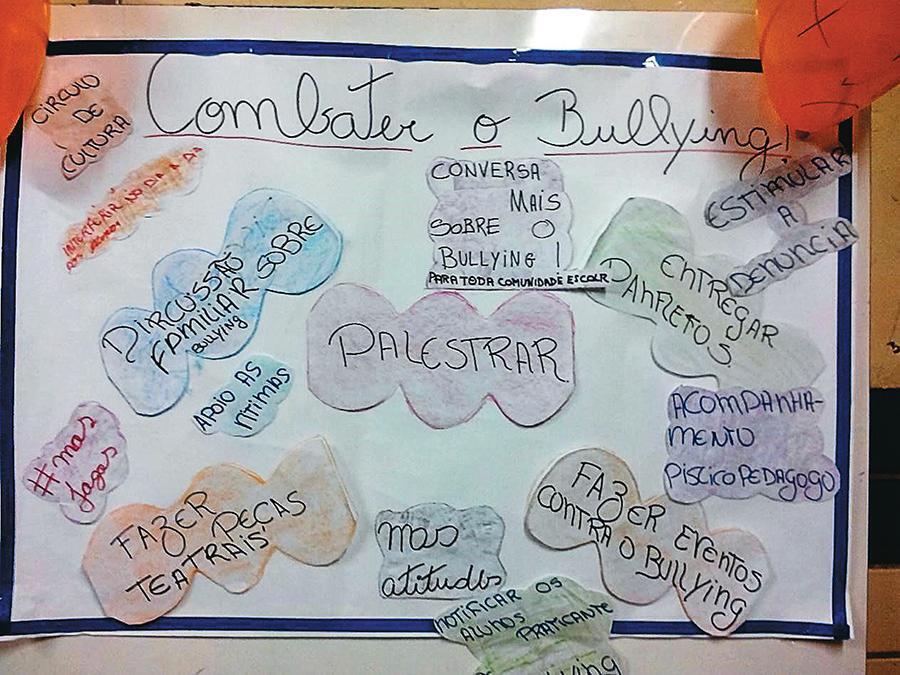
Search
Search in:
Nuvem de Tags
Adolescente (85) Atenção Primária à Saúde (239) COVID-19 (91) Criança (91) Cuidados de Enfermagem (269) Educação em Enfermagem (151) Educação em Saúde (139) Enfermagem (930) Enfermagem Pediátrica (86) Estudantes de Enfermagem (77) Estudos de Validação (131) Família (87) Idoso (208) Promoção da Saúde (99) Qualidade de Vida (104) Saúde do Trabalhador (86) Saúde Mental (145) Saúde Pública (82) Segurança do Paciente (150) Tecnologia Educacional (100)



